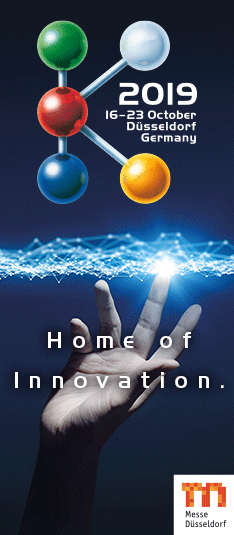| Plastics News |
Covestro and its partners develop a comprehensive interior concept and material solutions for the Car of the Future
The reinvention of mobility July 2, 2019 - The car of the future will be a multifunctional, mobile living and working space. This is the guiding principle of a new interior concept for future mobility, which Covestro will present at the K 2019 plastics trade fair. Like the smartphone, it will seamlessly accompany its user around the clock and adapt to his or her needs. The car of the future will be fully networked and seamlessly integrated into everyday life, where it will always provide the user with new experiences and the greatest possible autonomy. "Our comprehensive concept includes developments, which may become reality in a few years, but it also includes visionary ideas for the future," explains Jochen Hardt, Global Marketing Mobility at Covestro and project manager for the new concept. "We are particularly focused on the interior design, which can be both living and working space in an autonomous vehicle, offering customized experiences to the user. Future vehicle concepts for electromobility offer car manufacturers opportunities for completely new room concepts and additionally open up a new ground for brand differentiation.” Smart materials in the future car interior The interior is equally a matter of functionality, comfort and design, but also of efficiency. The focus is on optically and haptically designed surfaces, the integration of ambient lighting, latest infotainment systems and novel seating concepts. Covestro says its materials open up a kaleidoscope of new possibilities for many different components. For example, Makrolon polycarbonates and their blends will play an important role in the interior of the future. According to Covestro, they are notable for their maximum design freedom, mechanical stability, low weight and also provide good thermal and electrical insulation. Makrolon enables a range of glass-like surfaces and up to various functional colors, Covestro says. This is important for the integration of future innovative displays, sensors, cameras and ambient lighting systems. Maezio™ continuous fiber-reinforced thermoplastic composites from Covestro constitute a special class of composites. They are based on polycarbonate, but more robust and lightweight, due to reinforcement with carbon fibers, and are suitable e.g. for an efficient production of particularly thin-walled parts, the manufacturer explains. New dimension of infotainment Makrofol polycarbonate films are used, for example, for printed, even three-dimensional large-scale cover plates for the integration of displays. The films also serve as carrier for printed electronics in touchscreens. The number of such display surfaces and touchscreens in car interiors will increase drastically due to the progressing digitalization and networking (connectivity) as well as the trend towards autonomous driving. The seamless integration of displays is also supported by a new generation of Makrolon AI polycarbonate materials. Covestro also offers a range of Platilon thermoplastic polyurethane (TPU) films. Among other things, they are used as hotmelt films for bonding different materials like textiles. The sustainable INSQIN technology is used for textile coating in the car interior; it is based on solvent-free, waterborne polyurethane dispersions. Its use for the manufacture of coated textiles is efficient and saves water and energy, compared to conventional production. Classic jack-of-all-trades: Polyurethane Polyurethane is a classic but extremely versatile material for car interiors. In the form of soft or molded foam, it creates the basis for comfortable and safe car seats. Polyurethane foams have also been used for a long time in instrument panels, upholstery, trim parts and roof linings and provide comfort in the interior. With TPU coatings, surfaces can be created as desired – from particularly soft to hard. Polyurethane coatings are also geared towards high-quality surfaces with adjustable properties. Covestro says it develops raw materials for robust and abrasion-resistant coatings, which are available in various colors and surface structures that protect underlying substrates and create a pleasant feel when touched. The company also claims it is a pioneer in the formulation of aqueous coatings with low organic solvent content. Raw materials for polyurethane adhesives for solid and durable adhesive bonds round off the range. Trendy exterior design for electric cars At K 2016, Covestro for the first time dedicated itself to the mobility of the future on a larger scale and presented an integrated concept for the outer shell of electric cars. It was developed in close cooperation with design students from the renowned Umeå Institute of Design in Sweden and the automotive supplier HELLA. The development went beyond existing boundaries and offers new approaches for the attractive design of comfortable, functional and energy-efficient cars. The core elements are integrated sensors and antennas, holographic lighting, large-format display elements, 360-degree all-round glazing and seamless, homogeneous surfaces. Groundbreaking achievements time and again More than 50 years ago, still under the umbrella of Bayer, Covestro presented the first car with a complete plastic body at the plastics trade fair in Düsseldorf: the K 67. Since then, the company has repeatedly overcome limits with innovative material solutions. Later milestones included the introduction of headlamps and automotive glazing, both made of the transparent polycarbonate Makrolon. Covestro was also a pioneer in coating raw materials for waterborne automotive fillers and base coats as well as for low-solvent polyurethane clear coats. With 2018 sales of EUR 14.6 billion, Covestro is among the world’s largest polymer companies. Business activities are focused on the manufacture of high-tech polymer materials and the development of innovative solutions for products used in many areas of daily life. The main segments served are the automotive, construction, wood processing and furniture, and electrical and electronics industries. Other sectors include sports and leisure, cosmetics, health and the chemical industry itself. Covestro has 30 production sites worldwide and employs approximately 16,800 people (calculated as full-time equivalents) at the end of 2018. Source: Covestro .
|


